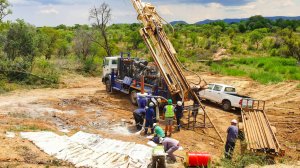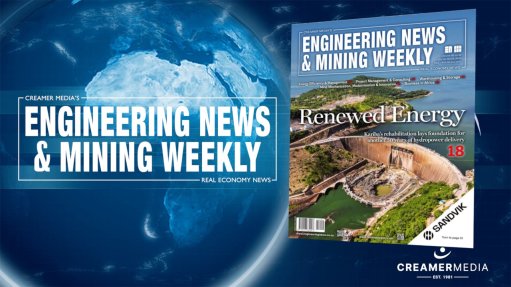Diamond miners require supportive regulation


ILLUMINATING OPERATION Botswana Diamonds exploring the Thorny River licence area
Government needs to provide regulatory laws that protect the interests of natural diamond owners with the rise of laboratory-grown diamonds in the market, Aim- and BSE-listed Botswana Diamonds MD James Campbell tells Mining Weekly.
Such owners need to be supported financially to continue explorative work to develop new diamond mines, he adds.
Over the years, the demand for lab-grown diamond jewellery has increased as consumers are opting for an alternative that offers bigger stones for less money.
Consequently, there has been speculation that such diamonds will result in reduced demand for natural diamonds.
Campbell mentions that regulatory policies to differentiate between natural mined diamonds and lab-grown diamonds will help protect the interests of natural miners in the Southern Africa region.
“I believe that the natural diamond industry, which has considerable assets in Southern Africa, is the future of mining, but it’s key to provide regulatory certainty to protect the interests of those mines. That’s why Botswana does so well; it has mastered the implementation of mining regulatory processes that support industry growth.”
Lab-grown vs Natural Diamonds
According to Campbell, what makes natural diamonds special is their rarity. He adds that the process of finding a diamond, then polishing it makes it more special.
Campbell says customers need to be educated about the difference between natural diamonds and lab-grown diamonds to know the quality of the stones: “If one chooses to buy a synthetic sapphire or gemstone, the price point will be much lower, compared with that of the natural sapphire, but the issue is that they don’t know what they are actually buying. Quality is key, especially because diamonds are synonymous with major life events, engagements, weddings and anniversaries.”
Exploration Challenges
Campbell notes that mining legislation in the Southern Africa region does not support exploration work, which adds to the funding challenges; this has also led to the growth of the lab-grown diamond industry because it is cheaper to support.
Local investors do not support explorers in the region with funding consequently being provided by international investors that charge higher interest rates to ensure a return on investment.
“It’s key for the region to provide funding for explorers, such as ourselves, to make discoveries, but it’s almost impossible to raise local money for exploration work. The lack of local support causes small companies to lose out, owing to the high interest rates charged by international shareholders.”
African countries struggle with affording companies the freedom to do explorative work, which makes exploration activity expensive to maintain. South Africa has many regulatory processes, compared with those of Botswana, which, in addition to funding challenges, further delays exploration work, he adds.
“Generally, there are many regulatory processes in Africa, but Botswana is one of the exceptions. Its processes are quick and efficient, with a highly professional civil service. It’s no surprise that people call it the Switzerland of Africa – it really works well.
“Whereas in South Africa, there’s a lot of work that needs to be done to improve the policy environment. It is a lot more difficult to operate there, and it takes a lot longer to get things done. Many of us believe that, if South Africa can get that right, it will improve the level of exploration expenditure in the country,” he says.
Meanwhile, Botswana Diamonds received a cash injection from projects with which it continued during Covid-19 pandemic lockdown, which allowed for explorative work to continue.
“We saw lockdown as being an opportunity, even with diamond prices initially dropping by more than 30%. During the lockdown, we were able to execute three deals.”
In a deal with diversified miner Petra Diamonds it managed to acquire diamond exploration assets for Sekaka Diamonds.
The Kalahari region of Botswana also has potential for a new diamond mine, while the Thorny River project, in Limpopo, South Africa, has potential for the exploration of small kimberlite blows in historically mined areas.
The company made an offer of $4-million to acquire the Ghaghoo kimberlite mine, in the Kalahari region, from diamond producer Gem Diamonds, but failed to reach the funding requirements before May 10, 2022.
“We made a conditional acquisition of the Ghaghoo diamond mine, but sadly, that’s fallen through we’re still looking for funding to try to develop that mine,” he says.
Campbell says the company is exploring in the Kalahari region under its subsidiary Sunland Minerals and through its Bamangwato Concessions Limited Joint Venture, Maibwe Diamonds.
Article Enquiry
Email Article
Save Article
To advertise email advertising@creamermedia.co.za or click here
Press Office
Announcements
What's On
Subscribe to improve your user experience...
Option 1 (equivalent of R125 a month):
Receive a weekly copy of Creamer Media's Engineering News & Mining Weekly magazine
(print copy for those in South Africa and e-magazine for those outside of South Africa)
Receive daily email newsletters
Access to full search results
Access archive of magazine back copies
Access to Projects in Progress
Access to ONE Research Report of your choice in PDF format
Option 2 (equivalent of R375 a month):
All benefits from Option 1
PLUS
Access to Creamer Media's Research Channel Africa for ALL Research Reports, in PDF format, on various industrial and mining sectors
including Electricity; Water; Energy Transition; Hydrogen; Roads, Rail and Ports; Coal; Gold; Platinum; Battery Metals; etc.
Already a subscriber?
Forgotten your password?
Receive weekly copy of Creamer Media's Engineering News & Mining Weekly magazine (print copy for those in South Africa and e-magazine for those outside of South Africa)
➕
Recieve daily email newsletters
➕
Access to full search results
➕
Access archive of magazine back copies
➕
Access to Projects in Progress
➕
Access to ONE Research Report of your choice in PDF format
RESEARCH CHANNEL AFRICA
R4500 (equivalent of R375 a month)
SUBSCRIBEAll benefits from Option 1
➕
Access to Creamer Media's Research Channel Africa for ALL Research Reports on various industrial and mining sectors, in PDF format, including on:
Electricity
➕
Water
➕
Energy Transition
➕
Hydrogen
➕
Roads, Rail and Ports
➕
Coal
➕
Gold
➕
Platinum
➕
Battery Metals
➕
etc.
Receive all benefits from Option 1 or Option 2 delivered to numerous people at your company
➕
Multiple User names and Passwords for simultaneous log-ins
➕
Intranet integration access to all in your organisation

















